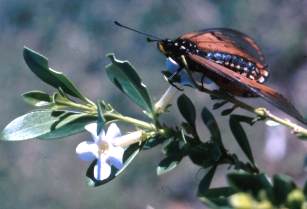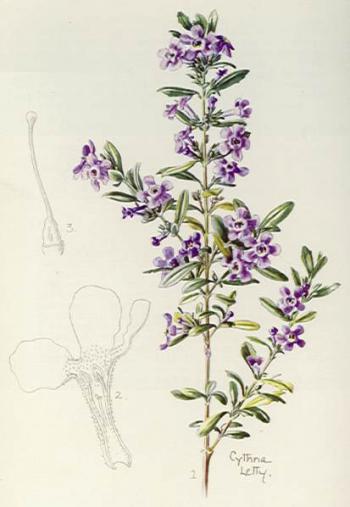Freylinia tropica
Freylinia tropica S. Moore
Family: Scrophulariaceae
Common names: Waterberg bell-bush, blue honey-bell, blue freylinia (Eng.), inyanga hedge plant (Shona)
Introduction
This shrub makes a good garden subject for summer rainfall areas.
Description
Description
Freylinia tropica is a beautiful shrub with slender rather loosely spreading branches. It is fairly fast growing and reaches a height of about 2m with 1m spread. It flowers profusely yielding a light mauve to bright blue display. A white flowering form is available and is not as upright in its growth form as the blue. Flowering time for this stunning shrub is mainly in spring.

Conservation Status
Status
Freylinia tropica is Red Listed as Rare but is not threatened. It is known from fewer than 10 subpopulations but none of them are threatened.
Distribution and habitat
Distribution description
The blue freylinia grows naturally in the Waterberg and Chimanimani Mountains in the Limpopo Province of South Africa and in Zimbabwe. It occurs at a high altitude, in margins of evergreen forest, on river banks and beside streams. It can be found growing on exposed misty mountain slopes. Where it occurs, it is frequently a pioneer plant on cleared land.

Derivation of name and historical aspects
History
This genus was named after Count L. de Freylino, owner of a famous garden at Buttigliera near Marengo in the early 19th century. There are 9 species of Freylinia in South Africa, of which 8 are found in the Cape Province. South African species are: F. crispa, F. densiflora, F. helmei, F. lanceolata, F. longiflora, F. tropica, F. undulata, F. visseri and F. vlokii.
Growing Freylinia tropica
Grow
The quickest way of propagating Frelinia tropica is by using cuttings. One may also use seeds as a way of building up genetic variance. Cuttings should be taken during the growing season, unless they are grown in a sophisticated growing structure with artificial heating and a mist bed. For a high percentage of rooting, cuttings should be treated with root stimulating hormones. Root formation can be expected between 10 - 22 days. Rooted cuttings may be hardened off by exposing them to more light and reducing the supply of water. Strong cuttings can then be planted in nursery planting bags before transplanting into the garden.

Plant Freylinia tropica in semi-shade, with good; well-drained soil and plenty of compost. Freylinia tropica requires a water supply throughout the year, but less in winter. It can withstand cold and frost but young plants must be protected during the first winter. Trimming keeps this plant neat and encourages bushiness.
Freylinia tropica is used often in South African gardens for screening. The plants also do well in containers on the patio. They are highly versatile and decorative shrubs and will work in most garden designs.
References
- Joffe, P.1993. The gardener’s guide to South African plants. Tafelberg Publishers, Cape Town.
- Coates Palgrave, K. 1983. Trees of southern Africa, 2nd Revised Edn. Struik Publishers, Cape Town, Johannesburg.
- Van Jaarsveld, E. & Raimondo, D. 2009. Freylinia tropica S.Moore. National Assessment: Red List of South African Plants version 2015.1. Accessed on 2016/03/15
Credits
Thompson T. Mutshinyalo
Walter Sisulu National Botanical Garden
September 2001
updated by Alice Notten
Kirstenbosch National Botanical Garden
March 2016
Plant Attributes:
Plant Type: Shrub
SA Distribution: Gauteng, Limpopo
Soil type: Loam
Flowering season: Spring
PH: Neutral
Flower colour: Blue, White, Mauve/Lilac
Aspect: Full Sun, Morning Sun (Semi Shade), Afternoon Sun (Semi Shade)
Gardening skill: Easy
Special Features:
Horticultural zones









Rate this article
Article well written and informative
Rate this plant
Is this an interesting plant?
Login to add your Comment
Back to topNot registered yet? Click here to register.